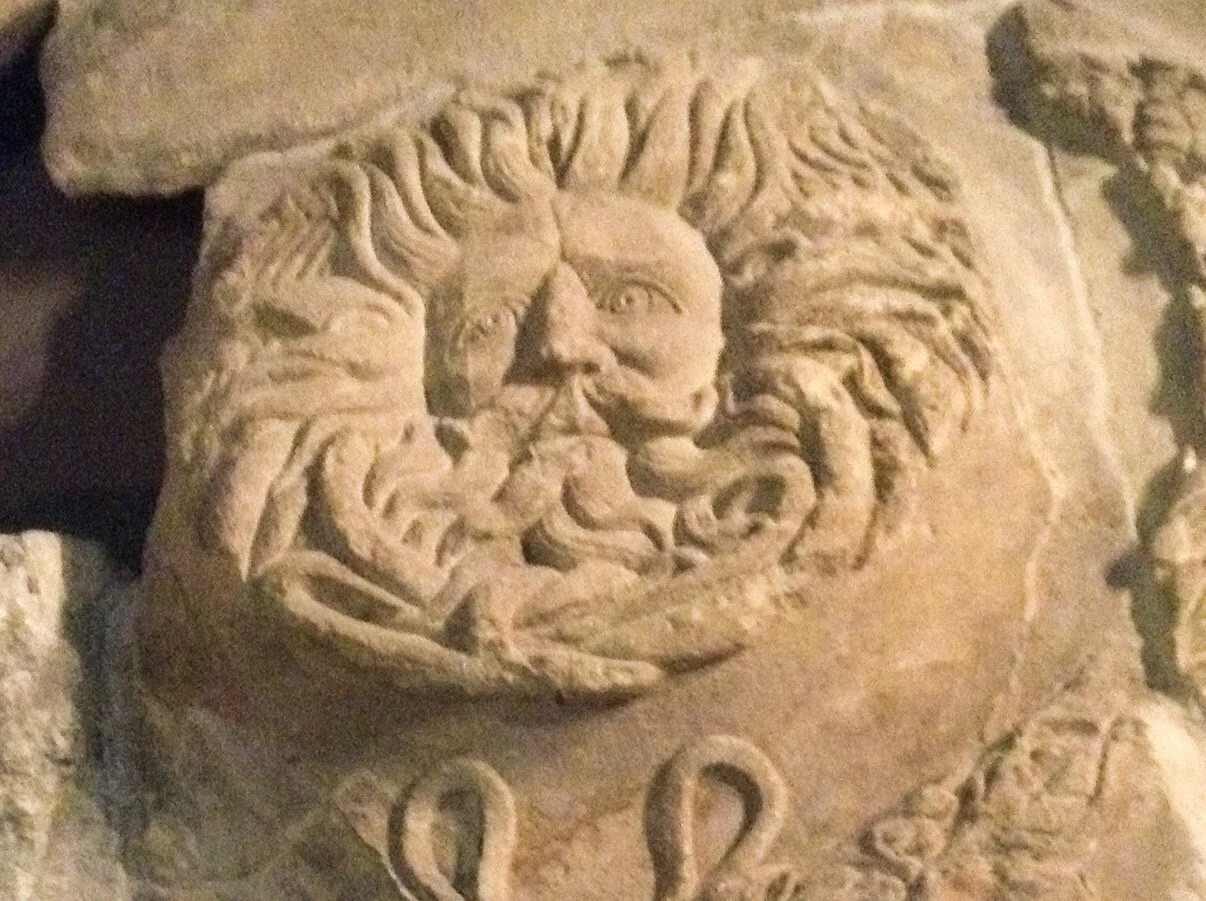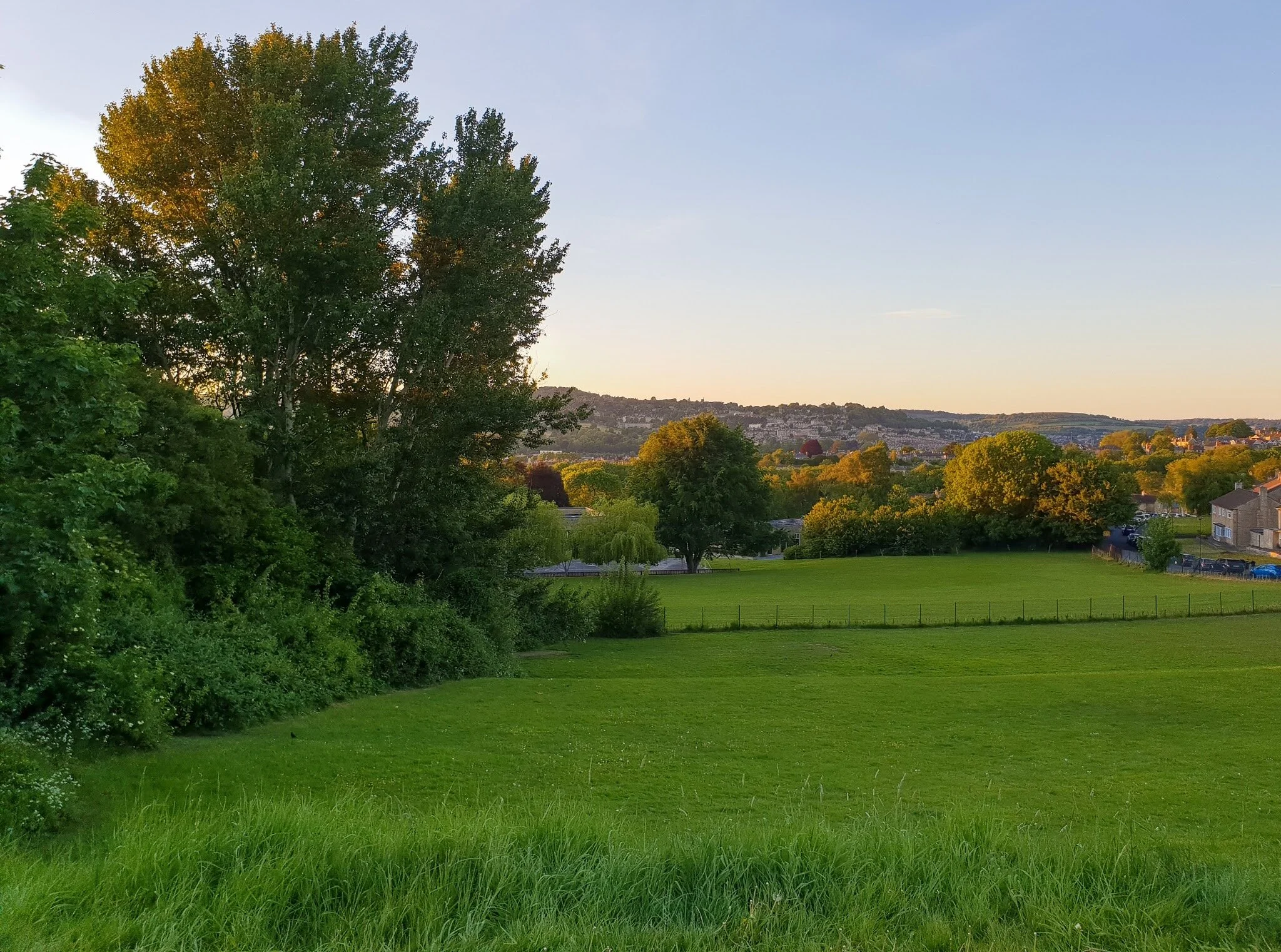Gorgon’s Head
The discoveries of archaeologists clearly show that the site of Aqua Sulis was a place where the Goddess Sulis Minerva was worshipped. Probably the most famous of these is the Temple pediment and the so-called Gorgon’s Head at its centre, which was discovered in 1790.
It is generally recognised that this is probably the work of sculptors from Gaul in the late first century AD. The quality of the workmanship is exceptional for Roman Britain and this would seem to indicate the importance of this site in Roman times. The pediment is full of allusions. In the corner are Tritons, half men, half fish and servants of Neptune, the water god. In the lower left centre is a face helmet in the form of a dolphin’s head. In the lower right of the central roundel is a small owl. The head itself has snakes entwined in its beard and hair and wings above its ears.
It is called the Gorgon’s head because one interpretation is that it represents the head of the Gorgon, a mythical creature killed by the Greek hero Perseus with the help of the Goddess Athena. Perseus gave her the head and ever afterwards she carried it on her shield. This seems to make sense as the Roman Minerva was the same as the Greek Athena. One problem with this, however, is that the Gorgon is female and the head is definitely male.
A possible explanation for this misinterpretation of the head is that early archaeologists, tended to see everything in classical terms and to overlook Celtic material. Richmond and Toynbee, writing in the Journal of Roman Studies in 1955, saw it as a water deity, wreathed with leaves and snakes. A more esoteric reading of it, however, would seem to show that it is in fact more likely to be a Celtic ‘sun-head’ and possibly that of the Celtic Sun God, Belinus, identified by the Greeks and Romans with Apollo. The presence of wings and ears are typical solar attributes for an all-seeing all-hearing god, the ‘snakes’ surrounding the head are more likely flames and the presence of the two intertwined snakes around the lower part could suggest a torc, the Celtic neck ornament of magical power, which symbolized the union with the forces of nature.
In fact, the Rev. Professor Sayce, who was one of the first experts to examine the head in 1890, saw it as a possible representation of King Bladud, a master of magic and necromancy in the Druid tradition. And it does have all the characteristics of a Celtic warrior. He also raised the question of who was worshipped and said that the flaming face proved there was a god by the side of the goddess and that while the goddess was worshipped in a separate temple, the hot springs and the baths which stood above them were under protection of the god. He said that, as the burning heat of the springs and of the sun were imagined to come from the same source, so the god of the springs was a form of sun god, but a sun god of the nether world, for whom the Celts had a special predilection.
A close-up of ‘The Gorgon’s Head’
Bob Stewart (The Waters of the Gap 1981) thinks that although the Temple Pediment has been taken for granted as that of Sulis Minerva it could equally well be that of the sun god himself. He says, ‘the goddess is more likely to have presided over the spring enclosure, while the baths themselves were used for therapeutic and religious practices associated with the overall cult.’
The early Celts were headhunters. They saw the head as a magical trophy or centre of power. There are many stories in Celtic mythology where a hero invades the Other World and brings back marvellous gifts to benefit the people. In the story of the Welsh hero, Bran, he goes to the Other World to plunder a magical cauldron. During a battle between the Irish and the Welsh, Bran is wounded by a poisoned spear and commands his followers to cut off his head. The head is taken to London and after many magical adventures on the way it is buried facing France according to Bran’s instructions.
In the light of this story Bob Stewart sees the head as a national guardian, the relic of a powerful king and Other World hero and says that the Bath head can be seen the same way as ‘a carving that showed the ancestral and sacred head cult in Celtic worship but developed as a solar deity. It represented a civilized and evolved phase of the old worship, in which the barbarous elements of the nomadic head hunters had long since been turned into a religion connected with the flow of the seasons, and the head became identified with a sun god.’
The head is mounted on a disc surrounded by a wreath of oak leaves. The oak was a magical tree to both the Romans and the Celts. Druids worshipped in tree groves and had particular reverence for the oak. The fertility of the land was linked to the potency of the king whose symbol was the oak tree. Pagan Irish killed and replaced their king if the land was not fertile. This human sacrifice was intended to make contact with the Other World and bring about an energy exchange for the benefit of all. The oak was also identified with lightning, seen as the sky fire fertilizing the earth and the classical thunderers Zeus and Jupiter were associated with the tree.
It is also linked with the Celtic god Belenos, whose name means ‘Brightly shining’. In folklore he is associated with the fertility of cattle and his name appears in the Celtic feast of Beltaine, a fire festival that marked the beginning of summer. This took place on the first of May and is still marked by May Day celebrations in Britain.
Belenos was the Celtic Apollo, a triumphant solar power of light. In fact, Bob Stewart sees the pediment as a cosmology. ‘Above is a star, the distant power of the heavenly bodies which were watched so closely by mankind. The main feature is the Sun, flying through the air on his round of the seasons. As he is supported by Victories who are associated with Minerva in classical symbolism, he is the sun at midsummer, the glorious victor who has triumphed. Below him are the powers of the Sea, and below again are the powers of the Underworld, suggested by the Owl, bird of Hecate.’
So, in this interpretation of the ‘Gorgon’s head’ we can look at the site in Roman times and see a Celtic sun god, presiding over his temple, alongside the goddess Sulis Minerva and the continuance of Pagan worship at the site alongside the use of the Baths for bathing and therapeutic purposes.
The full majesty of the ‘Gorgon’s head. Notice the owl and the globe




